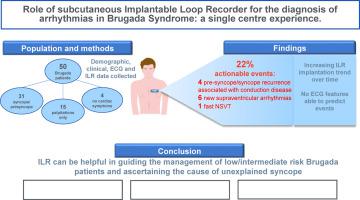Heart Rhythm ( IF 5.5 ) Pub Date : 2021-09-03 , DOI: 10.1016/j.hrthm.2021.08.034 Chiara Scrocco 1 , Yael Ben-Haim 1 , Brian Devine 2 , Maite Tome-Esteban 1 , Michael Papadakis 1 , Sanjay Sharma 1 , Peter W Macfarlane 2 , Elijah R Behr 1

|
Background
Experience with implantable loop recorders (ILRs) in Brugada syndrome (BrS) is limited.
Objective
The purpose of this study was to evaluate the indications and yield of ILR monitoring in a single-center BrS registry.
Methods
Demographic, clinical and follow-up data of BrS patients with ILR were collected.
Results
Of 415 BrS patients recruited consecutively, 50 (12%) received an ILR (58% male). Mean age at ILR implantation was 44 ± 15 years. Thirty-one (62%) had experienced syncopal or presyncopal episodes, and 23 (46%) had palpitations. During median follow-up of 28 months (range 1–68), actionable events were detected in 11 subjects (22%); 7 had recurrences of syncope/presyncope, with 4 showing defects in sinus node function or atrioventricular conduction. New supraventricular tachyarrhythmias were recorded in 6 subjects; a run of fast nonsustained ventricular tachycardia was detected in 1 patient. Patients implanted with an ILR were less likely to show a spontaneous type 1 pattern or depolarization electrocardiographic (ECG) abnormalities compared to those receiving a primary prevention implantable-cardioverter defibrillator. Age at implantation, gender, Shanghai score, and ECG parameters did not differ between subjects with and those without actionable events. ILR-related complications occurred in 3 cases (6%).
Conclusion
In a large cohort of BrS patients, continuous ILR monitoring yielded a diagnosis of tachy- or bradyarrhythmic episodes in 22% of cases. Recurrences of syncope were associated with bradyarrhythmic events. Use of ILR can be helpful in guiding the management of low-/intermediate-risk BrS patients and ascertaining the cause of unexplained syncope.
中文翻译:

皮下植入式循环记录器在 Brugada 综合征心律失常诊断中的作用:英国单中心经验
背景
在 Brugada 综合征 (BrS) 中使用植入式循环记录器 (ILR) 的经验有限。
客观的
本研究的目的是评估单中心 BrS 登记中 ILR 监测的适应症和收益。
方法
收集了患有 ILR 的 BrS 患者的人口统计学、临床和随访数据。
结果
在连续招募的 415 名 BrS 患者中,50 名 (12%) 接受了 ILR(58% 为男性)。ILR 植入的平均年龄为 44 ± 15 岁。31 人 (62%) 经历过晕厥或晕厥前发作,23 人 (46%) 有心悸。在 28 个月(范围 1-68)的中位随访期间,在 11 名受试者 (22%) 中检测到可采取行动的事件;7 例晕厥/晕厥前兆复发,其中 4 例显示窦房结功能或房室传导缺陷。6 名受试者记录到新的室上性心动过速;在 1 名患者中检测到一连串快速非持续性室性心动过速。与接受初级预防植入式心律转复除颤器的患者相比,植入 ILR 的患者不太可能出现自发 1 型模式或去极化心电图 (ECG) 异常。着床年龄、性别、Shanghai 评分和 ECG 参数在有和没有可操作事件的受试者之间没有差异。ILR相关并发症3例(6%)发生。
结论
在一大群 BrS 患者中,持续的 ILR 监测在 22% 的病例中诊断出快速或缓慢性心律失常发作。晕厥的复发与缓慢性心律失常事件有关。使用 ILR 有助于指导低/中危 BrS 患者的管理,并确定不明原因晕厥的原因。



























 京公网安备 11010802027423号
京公网安备 11010802027423号